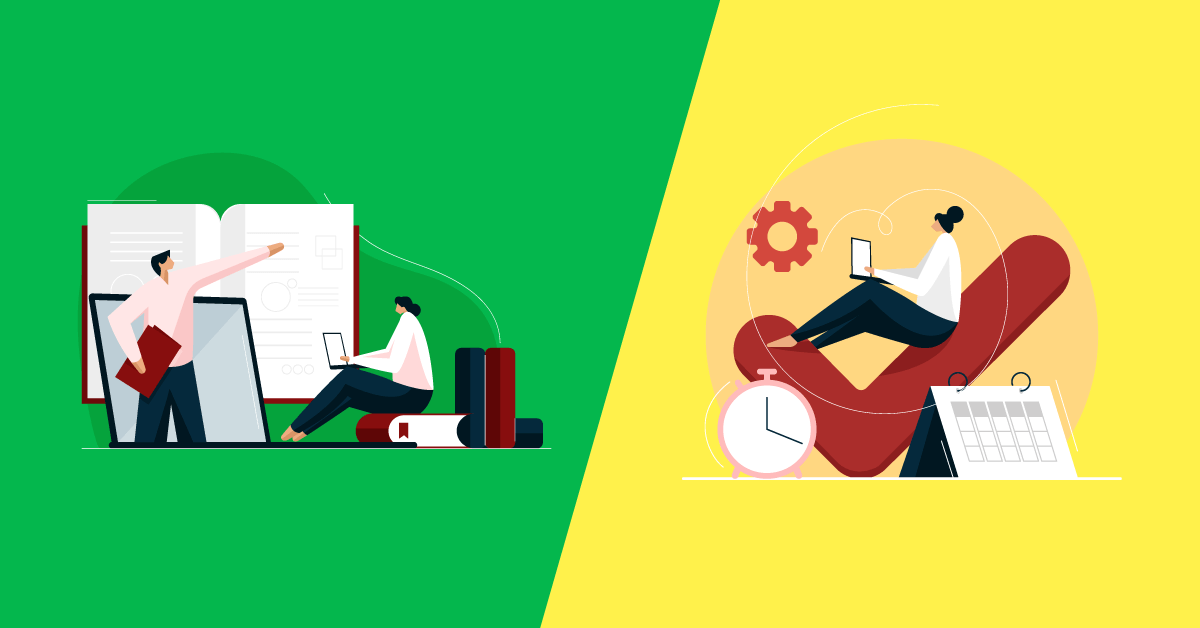However, for a long time, corporate trainers never fully understood the power of the adaptive learning approach. Many organizations still develop training programs based on “standard” company policies.
In taking this approach to corporate training, business leaders often fail to take one important fact into consideration: All people learn differently, and a one-size-fits-all approach to corporate training is likely to hinder learning outcomes.
Adapting your company’s training strategy
Most forward-thinking teaching approaches today believe that cookie-cutter training models aren’t where the future lies. To achieve better learning outcomes, you need to design and implement an adaptive learning strategy that enables your employees to personalize how and when they learn.
So, what is adaptive learning? And what makes it different from most other acknowledged training approaches?
The principles of adaptive learning are simple:
Give employees the ability to learn when they want, how they want, and what they want, and the learning outcomes will be far more positive than forcing employees to learn in accordance to rigid corporate training policies and dictates.
Obviously the “When”, “What”, and “How”, must all fall into broadly acceptable corporate parameters. For instance, if the new product is to be launched next week, you shouldn’t allow employees to learn about it the night before!
The idea behind adaptive learning strategies isn’t new. Employers have always aspired to adapt corporate learning to the needs of their workforce. However, with today’s technological innovations, adaptive learning has become more of a reality than a mere aspiration.
The power of adaptive learning unlocked
So, how exactly does an adaptive learning approach add benefit to a company’s training strategy?
It does so on several levels, but most importantly it enables company staff to learn in ways that they find effective. What this means is that your learners don’t have to adapt to how you are training them anymore.
Instead, your training approaches adapt to overcome the everyday corporate training and learning challenges that you and your staff face. This ends in a win-win situation for both, the company as well as employees being trained.
Consider the following situations:
1) Timing challenges
The employees, whom you wish to train on a new product or service, are extremely busy supporting a crucial project for the company. You just can’t spare them for training until next month! But that will be too close to the impending new product/service launch date!
With an adaptive learning strategy in place, this should not be an issue at all!
Thanks to adaptive training technologies, corporate learners can now learn on-demand, whenever they have the time to do so. It could be on weekends, during project breaks, or even after regular business hours.
2) Scheduling challenges
You wanted to hold an important training session next month, but the lead instructor and some key support staff can’t be available full-time until the following month. Should you cancel your plans?
Because adaptive learning is largely online, usually delivered through an asynchronous model, your employees and instructors don’t need to coordinate schedules in order for the training to proceed.
Even with partial instructor availability, and a reduced complement of support staff, your company can still go ahead with its training plans next month!
3) Employee engagement challenges
The next group scheduled for training are a mix of new recruits to the company and company veterans. How will you ensure everyone stays engaged?
The benefit of having an adaptive learning strategy is that employees with divergent experiences and skills can all be trained “together” – yet each of them learns at their own pace. Every learner assimilates content when they are ready, without impacting their fellow learners.
By using solutions based on Simulation, Group participation, Gamification, Virtual Reality (VR), Augmented Reality (AR) and 3D, you can further heighten employee interest in training. Employees will be fully engaged in what they learn!
4) Content “richness” challenges
With a mix of Millennials and Gen-X’ers in your company, you fear that Millennial learners won’t take too kindly lengthy PowerPoint bulleted-text, while that’s all that seems to work with the older employees.
By adapting your learning strategy to your audience, you are able to embed content using multiple media into the same training initiative. While the Boomers and Gen-X’ers and Y’ers are following the course using the PowerPoint slides, Millennial employees can learn the same concepts and theories using podcasts, videos and other rich instructional media.
5) Evaluation challenges
With a hugely diverse workforce, how will you evaluate and assess whether individual learners have actually benefited from the training you just delivered?
The beauty of using an adaptive learning strategy is that it offers tremendous flexibility, not just in how employees are trained, but also in how individual learners are assessed and evaluated. Adaptive learning technology can even offer personalized learning paths, individual remedial lesson plans, and tailored recommendations for review and revisions.
While developing an adaptive learning strategy might look overbearing – it’s really not! If organizations invest the time and effort to put the right strategy in place, all of the above benefits, and more, can make for a quick payoff!
Adaptive learning best practices
How one goes about developing and implementing an adaptive learning strategy is extremely important. Here are some best practices to help you get started:
· Know your audience. Before you start putting a strategy together, identify who your learners are by conducting a comprehensive audience analysis
· Listen to your staff. Poll employees across the organization to get a sense of what they are looking for as part of a training strategy
· Revise, re-use, re-tool. Do not throw away all of your training content just yet! Instead, once you get a sense of what employees are looking for, you may see opportunity to re-purpose some of your existing investment
· Identify building-block components early: Because technology will be a key driver for the strategy, evaluate alternate technologies early in the process. This will help you better develop other building blocks for your strategy subsequently
· Engage in peer consultations: If possible, reach out to other organizations who have implemented such a strategy to learn from real-life examples of adaptive learning solutions that actually work
· Seek help: Engage with Subject Matter Experts (SMEs), specialized contractors, and experienced freelancers on related best practices and industry norms. Seek their input for developing and implementing personalized corporate adaptive learning policies and procedures for your company
· Test and evaluate: Despite the temptation, don’t launch with a “big bang”. Instead, do a pilot roll out first (perhaps to one Section, Department or Regional office), and evaluate results before deploying to a broader audience
A key to successful strategy development and implementation is adaptation. As part of your strategy, put in place processes to regularly review, revise and adapt the tactics to ever changing corporate and employee needs. With so many changes taking place each day – in technology as well as in training approaches – having a “build once and never change” strategy is bound to fail.
Stay focused!
As you already know, adaptive online learning is never about the technology!
While technology is certainly a key to making the strategy work, it is just an enabler. If designed appropriately, good strategies too will adapt to the technological environment prevalent across your organization.
For example, a well-designed adaptive learning strategy should allow employees to learn using their smartphones, tablets, laptops and even their desktop computers. There should also be sufficient flexibility built into the strategy so that employees can learn when and where they want – not just if they are on premises, or at designated “training” locations.
However, to achieve those results, it is vital that corporate adaptive learning strategy developers and implementers stay focused on objectives – to allow flexibility in learning – and not get side tracked by specific learning tools or technologies.


